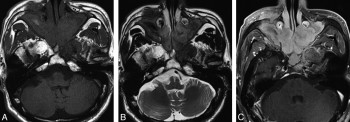
Tomoaki Sasaki, MD
Our article about IgG4-related diseases (IgG4-RD) described a very rare presentation in the head and neck, resembling malignant tumor. Mass lesions in the nasal cavity and paranasal sinuses can present difficulty in differential diagnosis. Fortunately, imaging usually plays a more important role in the evaluation of invasion and clinical stage than confirming a specific diagnosis. We have regarded bone marrow infiltration and perineural invasion as findings of advanced stage disease, however, the benign IgG4-RD also can have similar characteristics, raising the difficulty of a diagnostic strategy. Toyoda et al1 showed a tendency for cranial nerve enlargement in the IgG4-RD.1 We speculate that some lymphoproliferative diseases such as the IgG4-RD might have an affinity for the cranial nerves.
References
- Toyoda K, Oba H, Kutomi K, et al. MR imaging of IgG4-related disease in the head and neck and brain. AJNR Am J Neuroradiol 2012;33:2136–39, 10.3174/ajnr.A3147
